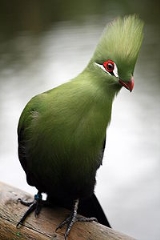
Knysna Turaco
Encyclopedia
The Knysna Turaco or, in South Africa
, Knysna Lourie, is a large turaco
, one of a group of Africa
n near-passerine bird
s. It is a resident breeder in the mature evergreen forests of southern and eastern South Africa, and Swaziland
. It was formerly sometimes considered to be a subspecies of the Green Turaco
of West Africa. The Livingstone's
and Schalow's Turaco
s were once considered subspecies
.
This species lays two egg
s in a shallow platform nest made from sticks and placed in a tree or clump of creepers.
Within its range, this is an unmistakable bird, although often inconspicuous in the treetops. It is 40–42 cm long, including a long tail. The small but thick orange-red bill and a white line just under the eye contrast with the mainly green plumage
. It has a tall green crest, which is tipped with white. The eye is brown and the eye-ring deep red. In flight, Knysna Turaco shows conspicuous crimson primary flight feathers. Sexes are similar, but juvenile birds have a shorter crest without the white tips.
The Knysna Turaco is usually seen flying between forest trees, or hopping along branches. It feeds on fruit, insects and earthworms. It has a loud kow-kow-kow-kow call.
South Africa
The Republic of South Africa is a country in southern Africa. Located at the southern tip of Africa, it is divided into nine provinces, with of coastline on the Atlantic and Indian oceans...
, Knysna Lourie, is a large turaco
Turaco
The turacos make up the bird family Musophagidae , which includes plantain-eaters and go-away-birds. In southern Africa both turacos and go-away-birds are commonly known as louries. They are semi-zygodactylous - the fourth toe can be switched back and forth...
, one of a group of Africa
Africa
Africa is the world's second largest and second most populous continent, after Asia. At about 30.2 million km² including adjacent islands, it covers 6% of the Earth's total surface area and 20.4% of the total land area...
n near-passerine bird
Bird
Birds are feathered, winged, bipedal, endothermic , egg-laying, vertebrate animals. Around 10,000 living species and 188 families makes them the most speciose class of tetrapod vertebrates. They inhabit ecosystems across the globe, from the Arctic to the Antarctic. Extant birds range in size from...
s. It is a resident breeder in the mature evergreen forests of southern and eastern South Africa, and Swaziland
Swaziland
Swaziland, officially the Kingdom of Swaziland , and sometimes called Ngwane or Swatini, is a landlocked country in Southern Africa, bordered to the north, south and west by South Africa, and to the east by Mozambique...
. It was formerly sometimes considered to be a subspecies of the Green Turaco
Green Turaco
The Guinea Turaco , also known as the Green Turaco, is a species of turaco, a group of near-passerines birds. It is found in forests of West and Central Africa, ranging from Senegal east to DR Congo and south to northern Angola. It lays two eggs in a tree platform nest...
of West Africa. The Livingstone's
Livingstone's Turaco
The Livingstone's Turaco is a species of bird in the Musophagidae family, which was named for Charles Livingstone, the brother of David Livingstone.It is distributed through the subtropical lowlands of southeastern Africa....
and Schalow's Turaco
Schalow's Turaco
The Schalow's Turaco is a frugivorous bird in the Musophagidae family. It is named after Herman Schalow. Mature birds have, on average, the longest crests of any turaco species....
s were once considered subspecies
Subspecies
Subspecies in biological classification, is either a taxonomic rank subordinate to species, ora taxonomic unit in that rank . A subspecies cannot be recognized in isolation: a species will either be recognized as having no subspecies at all or two or more, never just one...
.
This species lays two egg
Egg (biology)
An egg is an organic vessel in which an embryo first begins to develop. In most birds, reptiles, insects, molluscs, fish, and monotremes, an egg is the zygote, resulting from fertilization of the ovum, which is expelled from the body and permitted to develop outside the body until the developing...
s in a shallow platform nest made from sticks and placed in a tree or clump of creepers.
Within its range, this is an unmistakable bird, although often inconspicuous in the treetops. It is 40–42 cm long, including a long tail. The small but thick orange-red bill and a white line just under the eye contrast with the mainly green plumage
Plumage
Plumage refers both to the layer of feathers that cover a bird and the pattern, colour, and arrangement of those feathers. The pattern and colours of plumage vary between species and subspecies and can also vary between different age classes, sexes, and season. Within species there can also be a...
. It has a tall green crest, which is tipped with white. The eye is brown and the eye-ring deep red. In flight, Knysna Turaco shows conspicuous crimson primary flight feathers. Sexes are similar, but juvenile birds have a shorter crest without the white tips.
The Knysna Turaco is usually seen flying between forest trees, or hopping along branches. It feeds on fruit, insects and earthworms. It has a loud kow-kow-kow-kow call.

